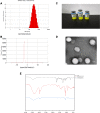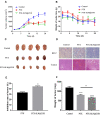Novel Curcumin Derivative-Decorated Ultralong-Circulating Paclitaxel Nanoparticles: A Novel Delivery System with Superior Anticancer Efficacy and Safety
- PMID: 36406640
- PMCID: PMC9673813
- DOI: 10.2147/IJN.S369761
Novel Curcumin Derivative-Decorated Ultralong-Circulating Paclitaxel Nanoparticles: A Novel Delivery System with Superior Anticancer Efficacy and Safety
Abstract
Purpose: Paclitaxel (PTX) has been widely utilized for the treatment of breast cancer. However, drawbacks, such as poor aqueous solubility, rapid blood clearance and severe toxicity, greatly reduce its efficacy and safety. Herein, a novel self-developed curcumin derivative (CUD) was chosen as the carrier to develop a long-acting PTX nano-delivery system (PTX-Sln@CUD) in order to improve its pharmacokinetic behavior, anti-breast cancer efficacy and safety.
Methods: PTX-Sln@CUD was prepared using solid dispersion and ultrasonic technology. Relevant physical and chemical properties, including stability and release behavior, were characterized. The clearance of PTX-Sln@CUD in vivo was studied by pharmacokinetic experiments. The anti-tumor activity of PTX-Sln@CUD was investigated in vitro and in vivo. Hemolysis experiments, acute toxicity and cumulative toxicity studies were performed in mice to determine the safety of PTX-Sln@CUD.
Results: The average particle size, PDI, Zeta potential, encapsulation efficiency and loading efficiency of the PTX-Sln@CUD were 238.5 ± 4.79 nm, 0.225 ± 0.011, -33.8 ± 1.26 mV, 94.20 ± 0.49% and 10.98 ± 0.31%, respectively. PTX-Sln@CUD was found to be stable at room temperature for half a year. The cumulative release rates of PTX-Sln@CUD at 24, 96 and 168 h were 17.98 ± 2.60, 57.09 ± 2.32 and 72.66 ± 4.16%, respectively, which were adherent to zero-order kinetics. T1/2, MRT (0-t) and AUC (0-t) of the PTX-Sln@CUD group were 4.03-fold (44.293 h), 7.78-fold (38.444 h) and 6.18-fold (14.716 mg/L*h) of the PTX group, respectively. PTX-Sln@CUD group demonstrated stronger anti-breast cancer activity than the PTX group. Importantly, the PTX-Sln@CUD group was safer compared to the PTX group both in vitro and in vivo.
Conclusion: PTX-Sln@CUD was verified as promising therapeutic nanoparticles for breast cancer and provided a novel strategy to solve the problem of low efficacy and poor safety of clinical chemotherapy drugs.
Keywords: breast cancer; curcumin derivative; long-acting; paclitaxel nanoparticles.
© 2022 Wei et al.
Conflict of interest statement
The authors declare that they have no competing interests in this work.
Figures











Similar articles
-
Solid lipid nanoparticle as an effective drug delivery system of a novel curcumin derivative: formulation, release in vitro and pharmacokinetics in vivo.Pharm Biol. 2022 Dec;60(1):2300-2307. doi: 10.1080/13880209.2022.2136205. Pharm Biol. 2022. PMID: 36606719 Free PMC article.
-
Construction of Curcumin and Paclitaxel Co-Loaded Lipid Nano Platform and Evaluation of Its Anti-Hepatoma Activity in vitro and Pharmacokinetics in vivo.Int J Nanomedicine. 2023 Apr 23;18:2087-2107. doi: 10.2147/IJN.S399289. eCollection 2023. Int J Nanomedicine. 2023. PMID: 37122500 Free PMC article.
-
Hyaluronic acid decorated pluronic P85 solid lipid nanoparticles as a potential carrier to overcome multidrug resistance in cervical and breast cancer.Biomed Pharmacother. 2017 Feb;86:595-604. doi: 10.1016/j.biopha.2016.12.041. Epub 2016 Dec 24. Biomed Pharmacother. 2017. PMID: 28027535
-
Anti-lung cancer effect of paclitaxel solid lipid nanoparticles delivery system with curcumin as co-loading partner in vitro and in vivo.Drug Deliv. 2022 Dec;29(1):1878-1891. doi: 10.1080/10717544.2022.2086938. Drug Deliv. 2022. PMID: 35748365 Free PMC article.
-
Formulation of the novel structure curcumin derivative-loaded solid lipid nanoparticles: synthesis, optimization, characterization and anti-tumor activity screening in vitro.Drug Deliv. 2022 Dec;29(1):2044-2057. doi: 10.1080/10717544.2022.2092235. Drug Deliv. 2022. PMID: 35775475 Free PMC article.
Cited by
-
Solid lipid nanoparticle as an effective drug delivery system of a novel curcumin derivative: formulation, release in vitro and pharmacokinetics in vivo.Pharm Biol. 2022 Dec;60(1):2300-2307. doi: 10.1080/13880209.2022.2136205. Pharm Biol. 2022. PMID: 36606719 Free PMC article.
-
Inhalable CAR-T cell-derived exosomes as paclitaxel carriers for treating lung cancer.J Transl Med. 2023 Jun 12;21(1):383. doi: 10.1186/s12967-023-04206-3. J Transl Med. 2023. PMID: 37308954 Free PMC article.
-
Anti atherosclerosis effect and mechanism of a novel curcumin analogue CACN136: regulating macrophage M1/M2 polarization and lipid metabolism.Front Pharmacol. 2025 Jun 25;16:1632647. doi: 10.3389/fphar.2025.1632647. eCollection 2025. Front Pharmacol. 2025. PMID: 40635740 Free PMC article.
-
Curcumin for Treating Breast Cancer: A Review of Molecular Mechanisms, Combinations with Anticancer Drugs, and Nanosystems.Pharmaceutics. 2024 Jan 5;16(1):79. doi: 10.3390/pharmaceutics16010079. Pharmaceutics. 2024. PMID: 38258090 Free PMC article. Review.
-
Construction of Curcumin and Paclitaxel Co-Loaded Lipid Nano Platform and Evaluation of Its Anti-Hepatoma Activity in vitro and Pharmacokinetics in vivo.Int J Nanomedicine. 2023 Apr 23;18:2087-2107. doi: 10.2147/IJN.S399289. eCollection 2023. Int J Nanomedicine. 2023. PMID: 37122500 Free PMC article.
References
MeSH terms
Substances
LinkOut - more resources
Full Text Sources

